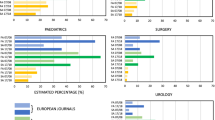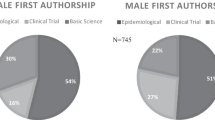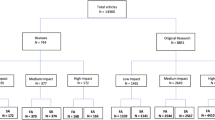Abstract
Purpose
While males have dominated the physician lines over the last decades the recent female doctors’ number increasing might progressively reduce this gender gap. This might be not fully true in the academic/research area. We aimed to analyze the gender distribution of first/senior Italian authors on neuroendocrine neoplasm papers published on peer reviewed journals.
Methods
Publications from January 2019 to September 2023 were reviewed; only papers with first and/or senior Italian authors were included. First/senior author gender, type of article, co-authorship with foreign authors were the variable analyzed.
Results
742 papers with Italian first and/or senior authors were retrieved, 449 (60.5%) multicentric, 285 (38.4%) original articles. A female author was first and senior author in 386/742 (52%) and in 228/742 (31%) papers, respectively. 150 (20.2%) papers included foreign coauthors, being an Italian female researcher first author in 50 papers (33%), senior author in 28 (18.6%). The number of Italian female first/senior authors has been increasing over the years (22 in 2019, 113 in 2022; 16 in 2019, 62 in 2022, respectively). The first/senior female authors were mainly Oncologists/Endocrinologists/Pathologists rather than Gastroenterologists/Nuclear Medicine doctors/Surgeons/Radiologists.
Conclusion
There has been an increase in the prevalence of female authorship of published research in the neuroendocrine setting over the last 5 years, which partially reflects the current distributions in this field, taking into account that several specialties with different gender distribution are involved. However, senior authorship continues to be primarily men. Efforts should be made to improve proportionate gender representation in both clinical and academic/research setting.



Similar content being viewed by others
References
Shannon G, Minckas N, Tan D, Haghparast-Bidgoli H, Batura N, Mannell J (2019) Feminisation of the health workforce and wage conditions of health professions: An exploratory analysis. Hum Resour Health 17:84
Abramo G, D’Angelo CA, Caprasecca A (2009) Gender differences in research productivity: a bibliometric analysis of the Italian academic system. Scientometrics 79:517–539. https://doi.org/10.1007/s11192-007-2046-8
Lavrière V, Ni C, Gingras Y, Cronin B, Sugimoto CR (2013) Bibliometrics: global gender disparities in science. Nature 504:2011–2013. https://doi.org/10.1038/504211a
Pololi LH, Civian JT, Brennan RT et al (2012) Experiencing the culture of academic medicine: gender matters, a national study. Gen Intern Med 28:201–207
Larese Filon F, Paniz E, Prodi A (2019) The gender gap in Italian academic medicine from 2005 to 2015: still a glass ceiling. Med Lav 110:29–36. https://doi.org/10.23749/mdl.v110i1.7617
Cheng D, Promes S, Clem K et al (2008) Chairperson and faculty gender in academic emergency medicine departments. Acad Emerg Med 13:9046
Hamel MB, Ingelfinger JR, Phimister E et al (2006) Women in academic medicine–progress and challenges. N Engl J Med 355:310–312
Dasari A, Shen C, Halperin D et al (2017) Trends in the incidence, prevalence, and survival outcomes in patients with neuroendocrine tumors in the United States, JAMA. Oncol 3:1335–1342. https://doi.org/10.1001/JAMAONCOL.2017.0589
Garcia-Carbonero R, Matute Teresa F, Mercader-Cidoncha E, Mitjavila-Casanovas M, Robledo M, Tena I, Alvarez-Escola C, Arístegui M, Bella-Cueto MR, Ferrer-Albiach C, Hanzu FA (2021) Multidisciplinary practice guidelines for the diagnosis, genetic counseling and treatment of pheochromocytomas and paragangliomas. Clin Transl Oncol 23:1995–2019. https://doi.org/10.1007/s12094-021-02622-9
Natalicchio A, Faggiano A, Zatelli MC, Argentiero A, D’Oronzo S, Marrano N, Beretta GD, Acquati S, Adinolfi V, Di Bartolo P, Danesi R, Ferrari P, Gori S, Morviducci L, Russo A, Tuveri E, Montagnani M, Gallo M, Silvestris N, Giorgino F (2022) Metabolic disorders and gastroenteropancreatic-neuroendocrine tumors (GEP-NETs): How do they influence each other? An Italian Association of Medical Oncology (AIOM)/ Italian Association of Medical Diabetologists (AMD)/ Italian Society of Endocrinology (SIE)/ Italian Society of Pharmacology (SIF) multidisciplinary consensus position paper. Crit Rev Oncol Hematol 169:103572. https://doi.org/10.1016/j.critrevonc.2021.103572
Rinke A, Müller HH, Schade-Brittinger C, Klose KJ, Barth P, Wied M, Mayer C, Aminossadati B, Pape UF, Bläker M, Harder J, Arnold C, Gress T, Arnold R; PROMID Study Group (2009) Placebo-controlled, double-blind, prospective, randomized study on the effect of octreotide LAR in the control of tumor growth in patients with metastatic neuroendocrine midgut tumors: a report from the PROMID Study Group. J Clin Oncol 27:4656–4663
Caplin ME, Pavel M, Ćwikła JB, Phan AT, Raderer M, Sedláčková E, Cadiot G, Wolin EM, Capdevila J, Wall L, Rindi G, Langley A, Martinez S, Blumberg J, Ruszniewski P, Investigators CLARINET (2014) Lanreotide in metastatic enteropancreatic neuroendocrine tumors. N Engl J Med 371:224–233
La Salvia A, Modica R, Rossi RE, Spada F, Rinzivillo M, Panzuto F, Faggiano A, Cinieri S, Fazio N (2023) Targeting neuroendocrine tumors with octreotide and lanreotide: Key points for clinical practice from NET specialists. Cancer Treat Rev 117:102560
Yao JC, Shah MH, Ito T et al (2011) Everolimus for advanced pancreatic neuroendocrine tumors. N Engl J Med 364:514–523
Raymond E, Dahan L, Raoul JL et al (2011) Sunitinib malate for the treatment of pancreatic neuroendocrine tumors. N Engl J Med 364:501–513
Strosberg JR, Caplin ME, Kunz PL, Ruszniewski PB, Bodei L, Hendifar A, Mittra E, Wolin EM, Yao JC, Pavel ME, Grande E, Van Cutsem E, Seregni E, Duarte H, Gericke G, Bartalotta A, Mariani MF, Demange A, Mutevelic S, Krenning EP, NETTER-1 Investigators (2021) 177Lu-Dotatate plus long-acting octreotide versus high-dose long-acting octreotide in patients with midgut neuroendocrine tumours (NETTER-1): final overall survival and long-term safety results from an open-label, randomised, controlled, phase 3 trial. Lancet Oncol 22:1752–1763
Modica R, Liccardi A, Minotta R, Cannavale G, Benevento E, Colao A (2022) Therapeutic strategies for patients with neuroendocrine neoplasms: current perspectives. Expert Rev Endocrinol Metab 17:389–403. https://doi.org/10.1080/17446651.2022.2099840
Dieci MV, Massari F, Giusti R et al (2018) Gender influence on professional satisfaction and gender issue perception among young oncologists. A survey of the Young Oncologists Working Group of the Italian Association of Medical Oncology (AIOM). ESMO Open 3:e000389. https://doi.org/10.1136/esmoopen-2018-000389
Foley C, Harewood G, Benz E, Higgins L, Gibbons E, Kelly S, Cheriyan D (2022) Gender equality in academic gastroenterology: a review of gastroenterology literature over four decades. Ir J Med Sci 191:745–748
Sidhu R, Rajashekhar P, Lavin VL, Parry J, Attwood J, Holdcroft A, Sanders DS (2009) The gender imbalance in academic medicine: a study of female authorship in the united kingdom. J R Soc Med 102:337–342
Pashkova AA, Svider PF, Chang CY, Diaz L, Eloy JA, Eloy JD (2013) Gender disparity among US anaesthesiologists: are women underrepresented on academic ranks and scholarly productivity? Acta Anaesthesiol Scand 57:1058–1064
Polanco NAP, McNally BB, Levy C, Carey EJ, Palomique J, Tran TT (2020) Gender differences in hepatology medical literature. Dig Dis Sci 65:3014–3022
Waldhorn I, Dekel A, Morozov A, Alon ES, Stave D, Tsrooya NB, Schlosser S, Markel G, Bomze D, Meirson T (2022) Trends in women’s leadership of oncology clinical trials. Front Oncol 12:885275. https://doi.org/10.3389/fonc.2022.885275
Mantovani A, Sartori F (2019) Gender difference in authorship of clinical practice guidelines and position statements in endocrinology. J Endocrinol Invest 42:489–490
Buddeberg-Fischer B, Stamm M, Buddeberg C et al (2010) The impact of gender and parenthood on physicians’ careers—professional and personal situation seven years after graduation. BMC Health Serv Res 10:40
Schmitt CM (2015) Flute or tuba: women and publishing success in top gastroenterology journals. Gastrointest Endosc 81:1448–1450
Funding
This research did not receive any specific grant from funding agencies in the public, commercial, or not-for-profit sectors.
Author information
Authors and Affiliations
Contributions
All authors contributed to the study conception and design. Material preparation, data collection and analysis were performed by Roberta Elisa Rossi, Anna La Salvia, Roberta Modica and Francesca Spada. The first draft of the manuscript was written by Roberta Elisa Rossi and all authors commented on previous versions of the manuscript. All authors read and approved the final manuscript.
Corresponding author
Ethics declarations
Conflict of interest
The authors declare that there is no conflict of interest.
Research involving human participants and/or animals
Not applicable.
Informed consent
Not applicable.
Additional information
Publisher's Note
Springer Nature remains neutral with regard to jurisdictional claims in published maps and institutional affiliations.
Rights and permissions
Springer Nature or its licensor (e.g. a society or other partner) holds exclusive rights to this article under a publishing agreement with the author(s) or other rightsholder(s); author self-archiving of the accepted manuscript version of this article is solely governed by the terms of such publishing agreement and applicable law.
About this article
Cite this article
Rossi, R.E., La Salvia, A., Modica, R. et al. Authorship of Italian medical literature on neuroendocrine neoplasms: any gender gap?. J Endocrinol Invest (2024). https://doi.org/10.1007/s40618-024-02347-w
Received:
Accepted:
Published:
DOI: https://doi.org/10.1007/s40618-024-02347-w




